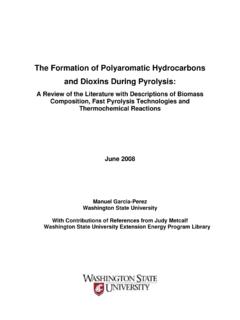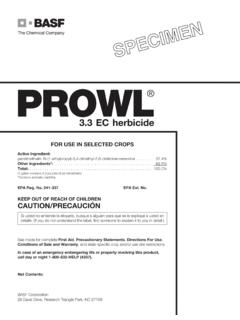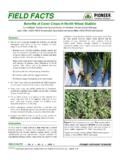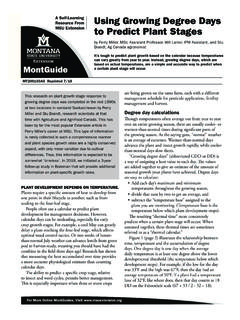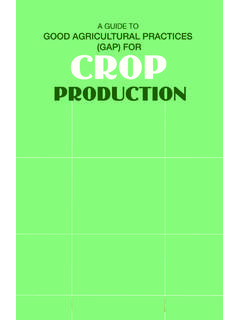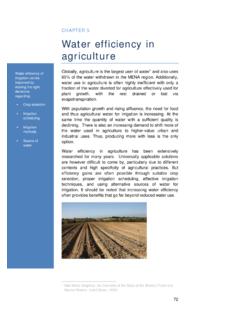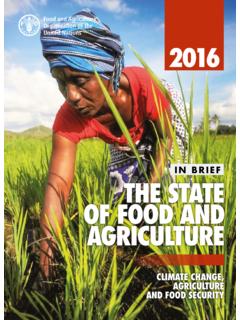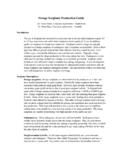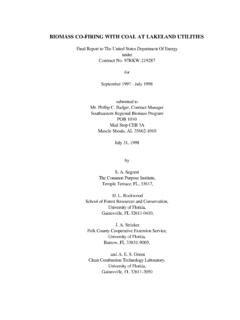Transcription of Outcrossing Potential for Brassica Species
1 Special Report 1064 January 2006 Outcrossing Potential for Brassica Speciesand Implications for Vegetable Crucifer Seed Crops of Growing Oilseed Brassicas in the Willamette ValleyOregon State University Extension ServiceSpecial Report 1064 January 2006 Outcrossing Potential for Brassica Speciesand Implications for Vegetable Crucifer Seed Crops of Growing Oilseed Brassicas in the Willamette ValleyJames R. Myers Oregon State UniversitySummaryThe oilseed mustards known as canola or rapeseed ( Brassica napus and B. rapa) are the same Species as some vegetable crucifers and are so closely related to others that interspecific and intergeneric crossing can occur. Intraspecific crosses (within the same Species ) readily occur among the following: B. napus canola with rutabaga and Siberian kale B.
2 Rapa canola with Chinese cabbage, Chinese mustard, pai-tsai, broccoli raab, and turnip Interspecific crosses (between different Species ) can occur among the following: Occur readily: B. napus canola with Chinese cabbage, Chinese mustard, pai-tsai, broccoli raab, and turnip Occur more rarely: B. napus or B. rapa canola with the B. oleracea cole crops (cabbage, kohlrabi, Brussels sprouts, broccoli, cauliflower, collards, and kale) Intergeneric crosses (between Species of different genera) are possible with varying degrees of probability: B. napus or B. rapa canola with wild and cultivated radish (Raphanus raphanis-trum and R. sativus) Many factors affect the probability of an interspecific cross, but the most important is proximity of the two Species . Many interspecific crosses need to occur for a few to succeed.
3 Thus, hybrid seeds rarely are detected more than 50 meters (165 feet) from the pollen-supplying parent. Because both wind and insects transfer pollen, very rare outcrosses can be detected up to 4 kilometers ( miles) away under special circum-stances. However, a distance of 2 kilometers ( miles) should be sufficient for stock seed production. Although it is relatively easy to maintain adequate distance between fields with pinning maps, other sources of canola seed present a greater threat to vegetable seed growers. The two greatest threats are canola seed blown from vehicles onto road shoulders and volunteers in fields previously planted to canola. Detecting and elimi-nating volunteers from a 2-kilometer radius around a seed field would be onerous and perhaps impossible. The introduction of genetically modified, herbicide-tolerant canola also constitutes a threat to vegetable seed production.
4 Herbicide resistance is unlikely to become established in weedy Species or seed crops. However, transgenes can be detected at very low frequency and would make a seed crop unsuitable for some markets. The best solution for introduction of canola into the Willamette Valley would be to maintain zones free of canola plantings and from traffic carrying canola seeds to crushing plants. Outcrossing Potential for Brassica Species and Implications for Vegetable Crucifer Seed Crops of Growing Oilseed Brassicas in the Willamette Valley James R. Myers2 IntroductionThe proposal to introduce substantial canola ( Brassica napus) acreage into the Willamette Valley for biodiesel produc-tion has caused concern among Brassica and Raphanus vegetable seed growers. The vegetable Species of the family Brassicaceae readily outcross, with pollen transferred by insects.
5 Seed growers are concerned about the Potential for canola pollen to contaminate their seed crops. In this paper, I describe Species relation-ships, discuss the literature on interspecific hybridization, and describe Potential impact on vegetable seed production. Identification of Brassicaceae speciesThe family Brassicaceae has more than 3,000 Species in 370 genera, a number of which have been brought into cultivation. Most rapeseed and canola are of the Species B. napus, although some cultivars are B. rapa. The vegetable Brassicaceae include the following: B. napus (rutabaga, Siberian kale) B. rapa (Chinese cabbage, pai-tsai, mizuna, Chinese mustard, broccoli raab, and turnip) B. oleracea (cabbage, broccoli, cauliflower, Brussels sprouts, kohlrabi, collards, kale) Raphanus sativus (radish)Condiment crops include B.
6 Nigra (black mustard), B. carinata (Ethiopian mustard), B. juncea (brown or Indian mustard), Armora-cea rusticana (horseradish), and a number of minor potherbs and salad vegetables. In the Willamette Valley, weedy crucifers of economic significance include black mus-tard (B. nigra), birdsrape mustard (B. rapa), wild mustard (Sinapsis arvensis; synonyms B. arvensis, B. kaber, S. kaber), wild radish (R. raphanistrum), sheperdspurse (Capsella bursa-pastoris), and bittercress (Cardamine hirsute) (E. Peachey, Oregon State University, personal communication). Brassica Species relationshipsBrassica Species relationships are com-plicated by the fact that new Species have arisen through the fusion of two progenitor Species . The relationships among Species were described in the classic work by U in 1935, in what is now termed the Triangle of U (Figure 1).
7 At the tips of the triangle are the Species with the fewest chromosomes B. nigra (N=8), B. oleracea (N=9), and B. rapa (N=10). These Species are diploid, meaning they have two sets of chromosomes. N is the number of chromosomes found in either the pollen or egg, thus one-half the number found in the adult some time in the past, the diploid spe-cies spontaneously hybridized to produce the allotetraploids. These Species have four sets of chromosomes, two from each parent Figure 1. Triangle of U (1935) (modified to include radish) showing genome relationships among cultivated Brassica Species . Genomes are represented by letters (A, B, C, or R), and haploid chromosome numbers are enclosed in (). Lines represent ease with which Species can be crossed. Diagram was modified to include more recent data on crossing among Species , including with Raphanus.
8 3species. They include B. carinata (N=17), B. juncea (N=18), and B. napus (N=19). There are two ways in which fertile allo-tetraploids can occur. In one case, unreduced gametes join. (Unreduced gametes are pollen or eggs having the full parental number of chromosomes rather than half the number.) In the other, normal fertilization occurs, fol-lowed by doubling of the chromosomes in the hybrid plant. Because allotetraploid Brassica Species share a genome with their diploid parents, gene flow can continue in both directions. Of particular relevance to the Potential for out-crossing between vegetable and oilseed Bras-sicas is the fact that B. napus was derived when B. rapa hybridized with B. oleracea (Figure 1).Although rare, allopolyploids have occurred repeatedly in nature and have been resynthesized by plant dispersion in BrassicasMost Brassica pollen disperses to within 10 meters (33 feet) of its source (Nieu-whof, 1963; Anonymous, 2002), although transfer has been detected up to 3 or 4 km ( to miles) away (Rieger et al.)
9 , 2002; Anonymous, 2002). Pollen may be moved by wind as well as by insects. Wind-transferred pollen has been detected up to km ( mile) from the source plant (Timmons et al., 1995). Pollen can live up to 4 or 5 days when temperatures are low and humidity is high. With warm temperatures and low humidity, survival time may drop to 1 or 2 days. Probability of intraspecific crossesRutabaga and Siberian kale are the same Species as B. napus oilseed cultivars and will cross readily with B. napus canola. Turnip, Chinese cabbage, and related Asian vegeta-bles are the same Species as B. rapa oilseed cultivars and cross readily with Outcrossing rates of 10 to 50 percent in canola (Anonymous, 2002), it is very likely that gene flow would occur between canola and rutabaga or Siberian kale.
10 The amount of gene flow would depend on many fac-tors: number of acres planted to canola, field distance, factors affecting pollen viability, and types of pollinators of interspecific hybridizationMany Brassica Species show a high degree of relatedness, which allows crossing to occur across Species and even genera (for example, wild radish with canola). Intercrossing occurs with varying degrees of about interspecific hybridiza-tion comes from two sources: (1) crosses attempted by plant breeders and geneticists and (2) natural hybrids found in the from artificial hybridization are dif-ficult to use in predicting Potential for natural crossing because special techniques such as embryo rescue may be used to obtain viable offspring. However, plant breeders normally report the number of successful crosses com-pared to the number of attempts, as well as whether artificial measures were used.

